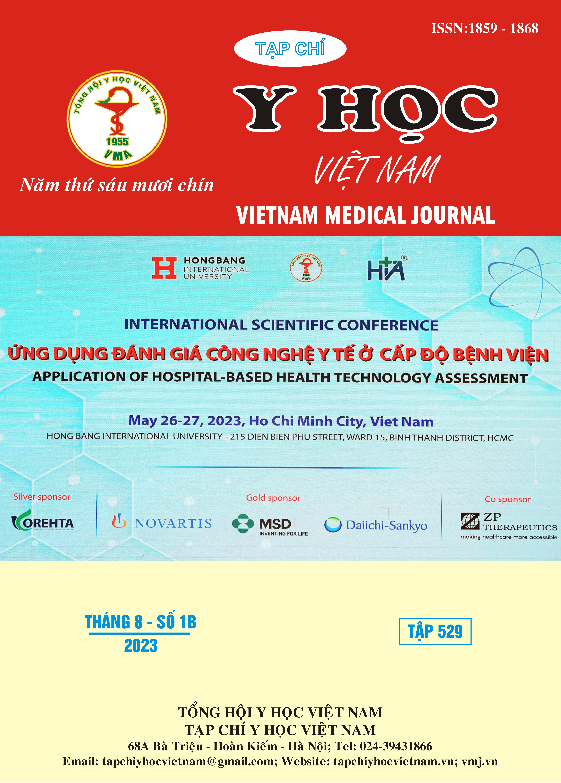NGHIÊN CỨU GIÁ TRỊ ĐO ĐẠC KÍCH THƯỚC CUNG RĂNG TRÊN MẪU HÀM SỐ HOÁ BẰNG PHƯƠNG PHÁP QUÉT TRỰC TIẾP TRONG MIỆNG VỚI CEREC PRIMESCAN
Nội dung chính của bài viết
Tóm tắt
Đặt vấn đề: Quét trong miệng là giai đoạn đầu tiên và rất quan trọng trong quy trình làm việc số hóa. Có nhiều hệ thống quét trong miệng đã được thương mại hoá nhưng chỉ một số hệ thống đã được đánh giá trên lâm sàng như hệ thống Lava COS, iTero, TRIOS. Mục tiêu nghiên cứu: Đánh giá độ chính xác và khả năng lặp lại khi đo đạc các kích thước của cung răng trên mẫu hàm số hoá từ việc quét trực tiếp trong miệng với hệ thống CEREC Primescan. (Primescan). Đối tượng và phương pháp nghiên cứu: Nghiên cứu in vitro với thiết kế nghiên cứu mô tả cắt ngang trên 60 cặp mẫu hàm thạch cao được lấy dấu truyền thống và 60 cặp mẫu hàm số hóa được quét bằng Primescan trên tình nguyện viên tương ứng. Kết quả: Kích thước gần-xa của răng dưới sau hai lần đo có sự khác nhau có ý nghĩa thống kê giữa hai phương pháp đo ở các răng số 32, 33, 36, 45, 46 trong lần đo thứ nhất và răng số 43 trong lần đo thứ hai. Không nhận thấy sự khác biệt giữa hai nhóm nghiên cứu khi đo chiều cao thân răng ở lần thứ hai. Độ cắn chìa và độ cắn phủ được đo bằng hai phương pháp cho thấy sự khác biệt đáng kể giữa hai lần đo. Không tìm thấy bất kỳ sự chênh lệch nào trên biến tỉ số tổng thể (phân tích Bolton) khi so sánh độ chính xác của hai phương pháp đo hay ở hai lần đo. Xét về khả năng lặp lại khi đo trên mẫu hàm số, chỉ có độ cắn chìa sau hai lần đo cho thấy sự khác biệt có ý nghĩa thống kê. Kết luận: So với đo đạc kích thước cung răng trên mẫu hàm thạch cao thì đo đạc trên mẫu hàm số hóa từ Primescan cho nhiều kết quả chính xác, có thể ứng dụng vào thực tiễn lâm sàng.
Chi tiết bài viết
Từ khóa
Độ chính xác, khả năng lặp lại, mẫu hàm số hoá, quét trong miệng, Cerec Primescan
Tài liệu tham khảo
2. Abduo J, Elseyoufi M (2018), “Accuracy of Intraoral Scanners: A Systematic Review of Influencing Factors”, Eur J Prosthodont Restor Dent, 26(3), pp. 101-121.
3. Camardella LT, Breuning H, (2017), "Accuracy and reproducibility of measurements on plaster models and digital models created using an intraoral scanner", Journal of Orofacial Orthopedics/Fortschritte der Kieferorthopädie, 78(3), pp. 211-220.
4. Grunheid T, McCarthy SD, Larson BE (2014), “Clinical use of a direct chairside oral scanner: an assessment of accuracy, time, and patient acceptance”, Am J Orthod Dentofacial Orthop, 146, pp. 673–682.
5. Goracci C, Franchi L and Ferrari M (2016), "Accuracy, reliability, and efficiency of intraoral scanners for full-arch impressions: a systematic review of the clinical evidence", European journal of orthodontics, 38(4), pp. 422-428.
6. Stevens DR, Flores-Mir C, Nebbe B et al (2006), “Validity, reliability, and reproducibility of plaster vs digital study models: comparison of peer assessment rating and Bolton analysis and their constituent measurements”, Am J Orthod Dentofac Orthop, 129, pp. 794–803.
7. Torassian G, Kau CH, English JD et al (2010), “Digital models vs plaster models using alginate and alginate substitute materials”, Angle Orthod, 80, pp. 474–481.
8. Wiranto MG, Engelbrecht WP, Nolthenius HET et al (2013), “Validity, reliability, and reproducibility of linear measurement on digital models obtained from intraoral and cone-beam computed tomography scans of alginate impressions”, Am J Orthod Dentofac Orthop, 143, pp. 140–147.


